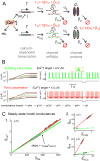Channeling the Central Dogma
- PMID: 24853932
- PMCID: PMC4085788
- DOI: 10.1016/j.neuron.2014.05.008
Channeling the Central Dogma
Abstract
How do neurons and networks achieve their characteristic electrical activity, regulate this activity homeostatically, and yet show population variability in expression? In this issue of Neuron, O'Leary et al. (2014) address some of these thorny questions in this theoretical analysis that starts with the Central Dogma.
Copyright © 2014 Elsevier Inc. All rights reserved.
Figures

Comment on
-
Cell types, network homeostasis, and pathological compensation from a biologically plausible ion channel expression model.Neuron. 2014 May 21;82(4):809-21. doi: 10.1016/j.neuron.2014.04.002. Neuron. 2014. PMID: 24853940 Free PMC article.
References
Publication types
MeSH terms
Substances
Grants and funding
LinkOut - more resources
Full Text Sources
Other Literature Sources

